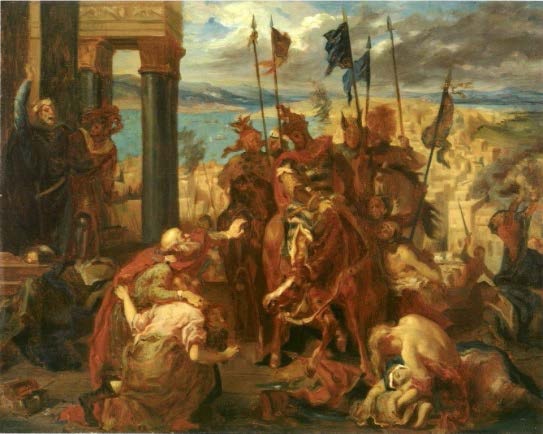
Eugène Delacroix
French, 1798-1863
The Entry of the Crusaders into Constantinople, 1839-1840
Oil on canvas
25 9/16 x 32"
Collins Fine Art, Ltd., New York
COMMENTS
The subject is the capture and sack of Constantinople in April 1204 at the end of the fourth crusade.
Baldwin IX of Flanders, the central figure in the painting, became the first Latin emperor of Constantinople; a Venetian, Thomas Morosini, became patriarch, and the doge of Venice added a sizeable portion of the Eastern empire to his domain. But so barbarous was the destruction and plunder of Constantinople, sparing neither holy buildings nor works of art, that nothing of its former splendor survived.
The picture was roundly criticized at the Salon on the familiar grounds of lack of unity, defective drawing, and inadequate finish, but also, more unusually, for dullness of color.
As for the widespread criticism of the coloring, it totally failed to take into account the fact that the climate can be extremely variable on the Bosporus and, more importantly, to comprehend the principles of Delacroix’s color practice that it masterfully embodies. Despite the cloudy sky, perhaps even because of it, if we consider Delacroix’s thoughts on overcast skies and color, the effects of plein air and the real light and atmosphere seem truer in the “Constantinople” than in any of Delacroix’s earlier Salon paintings. This development may be attributed primarily to the influence of Veronese.
The main principle of Veronese’s that Delacroix applies here concerns the handling of shadows. Instead of drowning the local colors in shadow with blacks and earths, he makes out the larger portion of this canvas in a half-tone which contains a considerable quantity of varied but muted local colors. Seen in isolation, these areas (the horseman on the left of the main group, for example) would seem comparatively highly colored, but in contrast to the brighter parts of the picture they appear to be in relative shadow. Delacroix thus eliminates academic chiaroscuro, which he considered to be a failing even of Rubens, and creates a natural impression of daylight penetrating shadow.
It was surely with such ideas in mid that Delacroix chose, most deliberately, to depict the entry of the crusaders under an overcast sky, largely in muted half-tones, but heightened in patches of sea, city and foreground figures with "pure accidents" of sunlight, like the laborer on the Champs-Elysées.
Another important aspect of the color in the “Constantinople” is that here for the first time there is conclusive evidence of Delacroix’s scientifically calculating complementary contrasts with a color circle; on a sheet of studies for the picture, he draws a faint color circle, writing the three primary colors and their complementaries on the circumference, and connects each primary to its complementary with a diameter. In the final picture, in addition to complementary contrasts in some of the costumes, three of the standards borne high by the crusaders display the primary contrasts, as through blazoning the principle: yellow and violet, blue and orange, red and green.
- Lee Johnson, The Paintings of Eugène Delacroix, A Critical Catalog, v. III, Oxford, Clarendon Press, 1986, pp. 95-9
SBMA CURATORIAL LABELS
In 1838, Delacroix was commissioned by King Louis-Philippe to paint a monumental canvas of this subject to decorate one of the halls at the Château of Versailles. For the 1840 Salon, Delacroix described the historical episode of the Crusades he has chosen to depict as follows: "Baldwin, count of Flanders, was in command of the French who had mounted an assault from the land side, and the aged doge Dandolo, leader of the Venetians, had attacked the port with his ships; the leaders move through the diverse sectors of the city, and weeping families beg for mercy as they pass."
This dazzling oil sketch retains all of the verve and brilliance of hue for which the artist was celebrated, while the large canvas for which it was an advanced study, now preserved at the Louvre, has sunken in tonality. It is therefore a precious record of the artist‘s intended palette. This is its first public exhibition since its recent discovery. Edgar Degas deeply admired this composition and emulated the weeping woman at the lower right corner repeatedly in his own work.
- Delacroix and the Matter of Finish, 2013
